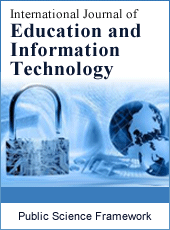International Journal of Education and Information Technology
Articles Information
International Journal of Education and Information Technology, Vol.1, No.1, Apr. 2015, Pub. Date: Apr. 20, 2015
Fuzzy Methods for Student Assessment
Pages: 20-28 Views: 3848 Downloads: 1608
[01]
Michael Gr. Voskoglou, Departmentof Applied Mathematics, Faculty of Technological Applications, Graduate Technological Educational Instituteof Western Greece, Patras, Greece.
[02]
Igor Ya. Subbotin, Department of Mathematics and Natural Sciences, College of Letters and Sciences, National University, Los Angeles, USA.
In the present paper we propose three different fuzzy methods for assessing a system’s performance: The measurement of its total possibilistic uncertainty, the Centre of Gravity (COG) defuzzification technique and the Trapezoidal Fuzzy Assessment Model (TRFAM). Although each one of the above methods can be applied independently, a combined utilization of them helps the user to get a more comprehensive view of the system’s performance, since they compensate for each other. In fact, while the first method is focusing on the system’s mean performance, the last two focus on its quality performance by assigning greater coefficients to the higher scores. Further, the TRFAM, which is a new original variation of the COG technique, treats better the ambiguous cases being at the boundaries between two successive assessment grades. An application (students’ assessment)is also presented illustrating our results, in which the above three fuzzy assessment methods are compared to each other and with two traditional assessment methods based on principles of the bivalent logic (calculation of means and of the GPA index).
System’s Uncertainty, Center of Gravity (COG) Defuzzification Technique, Trapezoidal Fuzzy Assessment Model (TRFAM), Grade Point Average (GPA) Index
[01]
Grade Point Average Assessment, available in the Web at: http://www.swinburne.edu.au/student-administration/assessment/gpa.html , visited October 15, 2014.
[02]
Klir, G. J., Folger, T. A., Fuzzy Sets, Uncertainty and Information, London, Prentice-Hall, London, 1988.
[03]
Klir, J. G., Principles of Uncertainty: What are they? Why do we mean them? , Fuzzy Sets and Systems, 74, 15-31, 1995.
[04]
Lin, L., Lee, H.-M., Fuzzy assessment method of sampling survey analysis, Expert Systems with Applications: An International Journal,36(3), 5955-5961, 2009.
[05]
Liu, H.-C., Wu, J., Li, P., Assessment of health-care waste disposal methods using a VIKOR-based fuzzy multi-criteria decision making method, Waste Management, 33(12), 2744-2751, 2013
[06]
Shackle, G. L. S., Decision, Order and Time in Human Affairs, Cambridge, Cambridge University Press, 1961.
[07]
Shang, H., Wang, X., Application of Fuzzy Assessment Method to Emergency Response Capability in Hazardous Materials Transportation, Innovative Computing, 2nd International Conference on Information and Control (ICICIC’07), p. 413, 2007
[08]
Shannon, C. E., A mathematical theory of communications, Bell Systems Technical Journal, 27, 379-423 and 623-656, 1948.
[09]
Subbotin, I. Ya., Badkoobehi, H., Bilotckii, N. N., Application of fuzzy logic to learning assessment. Didactics of Mathematics: Problems and Investigations, 22, 38-41, 2004.
[10]
Subbotin, I. Ya., Bilotskii, N. N., Triangular fuzzy logic model for learning assessment, Didactics of Mathematics: Problems and Investigations, 41, 84-88, 2014.
[11]
Subbotin, I. Ya, Voskoglou, M. Gr., A Triangular Fuzzy Model for Assessing Critical Thinking Skills, International Journal of Applications of Fuzzy Sets and Artificial intelligence,4, 173 -186, 2014.
[12]
Subbotin, I.Ya., Trapezoidal Fuzzy Logic Model for Learning Assessment, arXiv: 1407.0823 [math.GM], submitted on July 1, 2014.
[13]
van Broekhoven, E., De Baets, B., Fast and accurate centre of gravity defuzzification of fuzzy system outputs defined on trapezoidal fuzzy partitions, Fuzzy Sets and Systems, 157(7), 904-918, 2006.
[14]
Voskoglou, M. Gr., Stochastic and fuzzy models in Mathematics Education, Artificial Intelligence and Management, Saarbrucken- Germany, Lambert Academic Publishing, 2011.
[15]
Voskoglou, M. Gr., Subbotin, I.Ya., Dealing with the Fuzziness of Human Reasoning, International Journal of Applications of Fuzzy Sets and Artificial Intelligence, 3, 91-106, 2013.
[16]
Voskoglou, M. Gr., Fuzzy Logic as a Tool for Assessing Human Skills, International Journal of Mathematics and Computational Science, 1(2), 15-20, 2015
[17]
Wikipedia, Center of mass: Definition, available in the Web at:http://en.wikipedia.org/wiki/Center_of_mass#Definition , visited on October 10, 2014.
[18]
Wikipedia, Trapezoid: Other properties, available in the Web at:http://en.wikipedia.org/wiki/trapezoid#other_properties , visited on October 10, 2014.
[19]
Wikipedia, Center of mass: A system of particles, available in the Web at:http://en.wikipedia.org/wiki/Center_of_mass#A_system_of_particles , visited on October 10, 2014.

ISSN Print: 2381-7410
ISSN Online: 2381-7429
Current Issue:
Vol. 5, Issue 1, March Submit a Manuscript Join Editorial Board Join Reviewer Team
ISSN Online: 2381-7429
Current Issue:
Vol. 5, Issue 1, March Submit a Manuscript Join Editorial Board Join Reviewer Team
| About This Journal |
| All Issues |
| Open Access |
| Indexing |
| Payment Information |
| Author Guidelines |
| Review Process |
| Publication Ethics |
| Editorial Board |
| Peer Reviewers |


